
Pickup trucks: Is "quintessentially American" good or bad?
Pickup trucks, particularly full size ones, are rather popular. Marty Miller writes for Experian that they are "the most common vehicles in operation at 20% share" and that they represent a whole 16.5% of new vehicle registrations in the United States, as of August 2019. According to GoodCarBadCar, the Ford F-150, Ram Pickup, and Chevrolet Silverado were the top three sellers respectively as of the third quarter of 2020. It goes without saying that there is a lot of money, and a lot of interest, in full size pickup trucks right now.
Let's follow the money first. Jamie LaReau writes for the Detroit Free Press that as of 2018, the the average pickup purchase price was $43000. This is up by over $10000 from 2008, and is 30% greater than the corresponding average car purchase price. This price isn't simply accepted by buyers, either; though purchase prices are driven upwards by luxury- and value- oriented options and trim levels, consumers exhibit some hesitation about the sheer magnitude of full size pickup prices. LaReau quotes a CarGurus study that over 50% of respondents would forego such modern conveniences as lane keeping assist, an automatic tailgate, or a WiFi hotspot if doing so would return a lower price. There seems to be growing concern that these hot-selling trucks are outstripping the simple financial means of their average purchaser (note: LaReau reports that the average pickup buyer's household income is $100000). As always, however, the auto industry and its associated financial apparatus has a simple answer for this: 60-month lease terms. This, of course, is a double-edged sword: In ideal financial conditions, this makes high-value vehicles available for the middle class, but when considering the depreciation cars experience after five years (a typical pickup lease term), the proposition is risky for the consumer at best. Clifford Atiyeh writes for Car and Driver that "A third of car owners roll over their debt into new loans, compared to about a quarter before the recession." Atiyeh adds that "New-car loans are the longest and most expensive they've ever been" and mentions that the Wall Street Journal concluded that the American middle class simply cannot afford the cars it tends to buy. However, with all this risk, automakers are experiencing remarkable profits, with GM alone making $36.4 billion in the first half of 2018 off of their full size trucks and truck-based SUVs, according to the Detroit Free Press' Mark Phelan. It is no secret that automakers net substantially more profit per vehicle with trucks and SUVs compared to compact cars, and the pickup truck segment is simply the most amplified aspect of this trend. In short, pickup trucks are more expensive and profitable than ever, but are also more likely than ever to be sold on loan terms that are longer than ever, in a consumer environment with more new auto debt than ever: $584 billion, as of 2018, to be precise. Despite the apparent risk, this surely isn't much of a problem, so long as the economy stays stable, big lenders stay solvent, and Americans stay employed!
Perhaps that's all conjecture, however. Let's avoid the rather concerning supposition that the popularity of pickup trucks is a concerted marketing move by automakers to churn out record profits and sales on the back of deeply subsidized domestic gasoline prices and a prodigiously swollen consumer auto debt bubble for now, and instead think of what these trucks offer for their buyers.
It's difficult to deny that pickup trucks have achieved a sort of mythic status in the American cultural consciousness. Mark Phelan quotes for the Detroit Free Press that "it is a uniquely American perspective to be so invested in the ability to do it yourself. Pickup trucks communicate that image more perfectly than any other vehicle." This "do it yourself" ruggedness is commonly lauded, with the consensus seeming to be that pickup trucks now occupy a dual niche, both that of imposing utility vehicle and comfortable family car. Brett Berk writes for The Drive that pickup trucks offer a form of "butch drag" that allows their driver to don a "tough image" to "stand out in a crowd." It therefore seems that the consensus is that the modern pickup truck is a deeply performative vehicle choice, one that projects very specialized imagery for the driver and the world around them. Brian Kahn of Gizmodo takes this analysis one step further, connecting the consumptive nature of these pickup trucks (remember how sales have been inflated by artificially suppressed gas prices?) to their messaging of power and control, indicting that combination as a manifestation of "Petro-Masculinity." Kahn quotes that "fossil fuel use and extraction is emblematic of traditional values and America being great, synonymous with conservatism," with fossil fuels having transcended being merely an economic construction, but have become a central aspect of the modern American identity.
So, with all those cheery details in mind, let's talk about the Ram 1500, shall we?
First off, how does it feel?

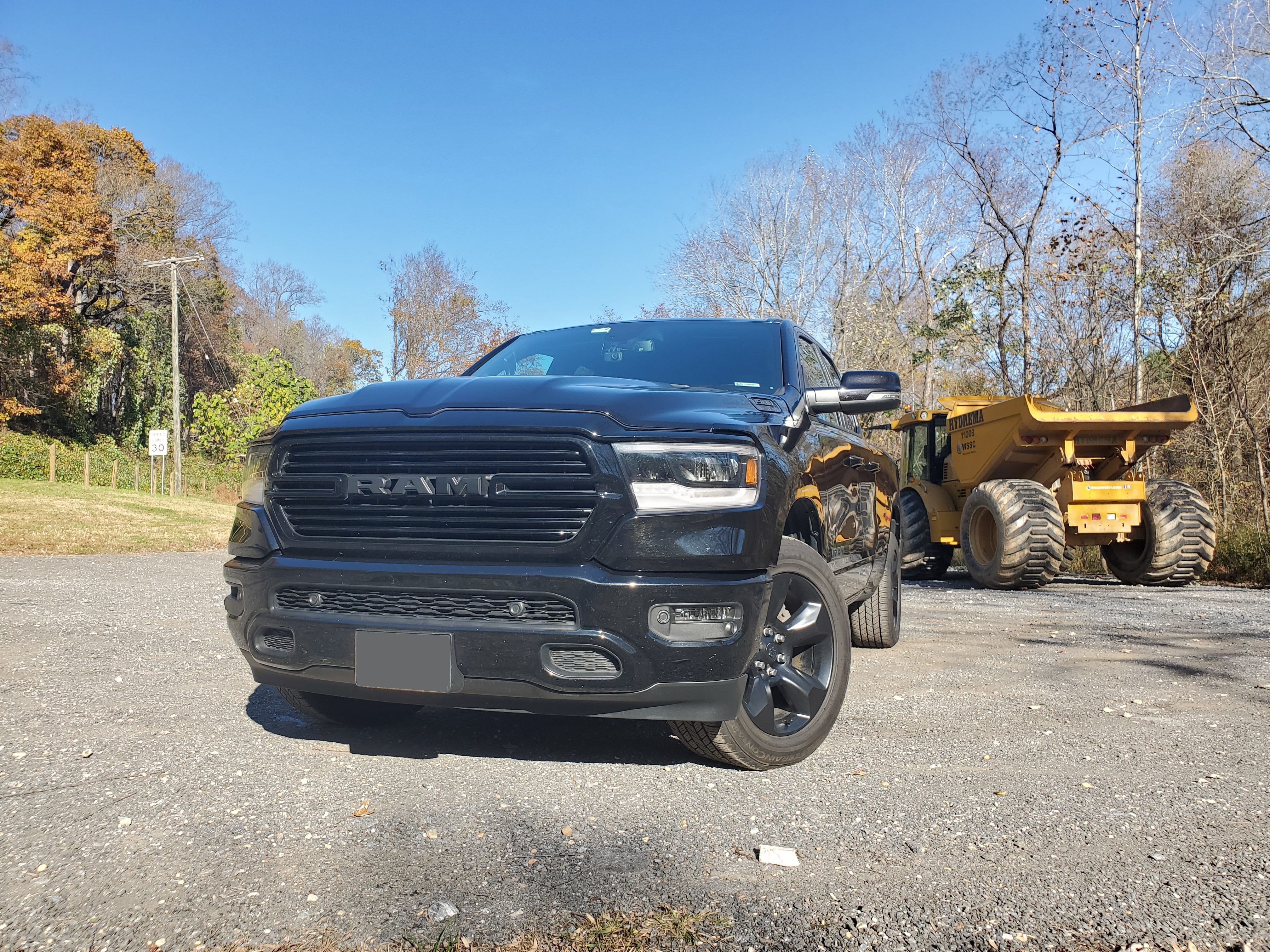
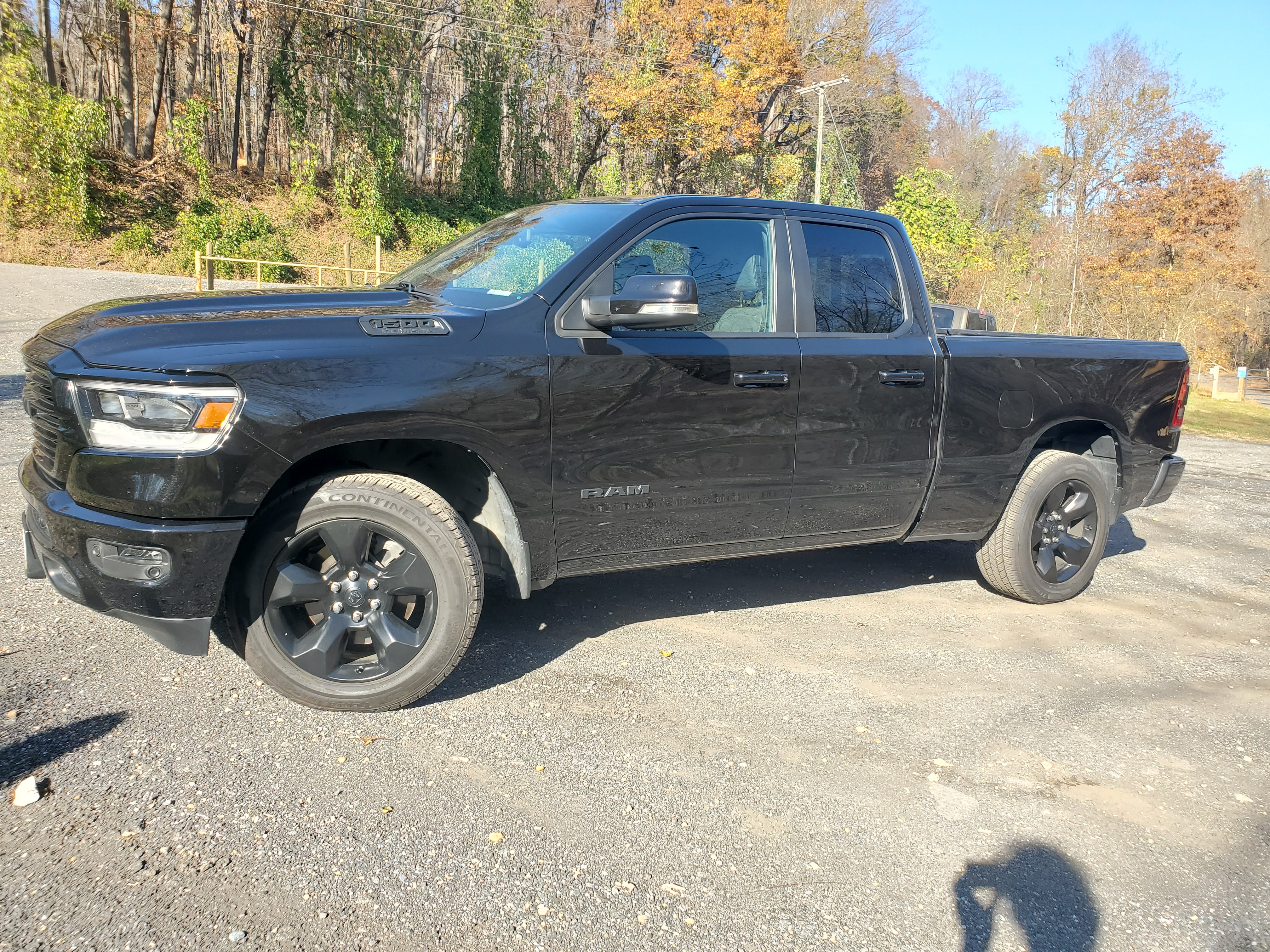
The absolute first impression that the Ram 1500 makes is its sheer size. For a modern full size pickup, the body is streamlined and rounded to some extent, that being more so than its primary competitors, but that doesn't help matters: This is simply a very large vehicle. Ram trucks seem to have mostly divested from their Dodge roots now, having discarded the venerable "crosshair" grille in favor of block letters on the grille and a huge plastic logo on the tailgate. No two door version is available any longer, instead coming with either a "quad cab" or "crew cab", the former of which this truck is equipped with. With the larger cab, the proportions of the truck look a little more natural from the side: The sheer El Capitan-like bulk of the hood is visually mitigated by the generously sized cab, tall ground clearance, and deep bed side walls. The front is visually busy, as so many cars are these days, with a lower bumper peppered now only by a lower grille, but also by fog lamp housings and a pair of cosmetic secondary vents. Overall, the styling affects a purposeful, muscular appearance, but without adopting the monolithic styling of the Silverado or F series.
The well-proportioned body can't hide the sheer height of the thing, however, and getting in to the cab takes work. The grab handles on the A-pillars are absolutely necessary for anyone shorter than 5'10". Once inside the cab, however, the user is greeted with that element of the Ram that so radically sets it apart from a normal sedan or car-based crossover: The sheer space inside. Legroom is more than generous, as is headroom, and the long seat adjustability travels combined with the moving brake pedal make the controls accessible for a broad range of figures. The cab's width is also quite apparent, though that is to be expected: In a typical truck like this, there would be a front bench with a fold-down armrest in the center. However, the Ram forgoes such practicality in favor of passenger amenities, notably, a cavernous central bin with multiple tiers of covered and uncovered storage above it. The rear seat, on the other hand, is a bench, and can seat three across or fold up for more interior cargo room (if the bed wasn't enough?). However, the rear seat's legroom is actually quite limited; despite the tall cabin and four-door cab, sitting behind a tall driver will leave the unfortunate passenger knocking their knees on the seat. The Ford EcoSport had better rear legroom than this quad cab Ram. Practically speaking, this is effectively a more user-friendly equivalent of 2+2 door cabs with the clamshell rear half doors. If you plan on carrying more than two adults, get the crew cab.


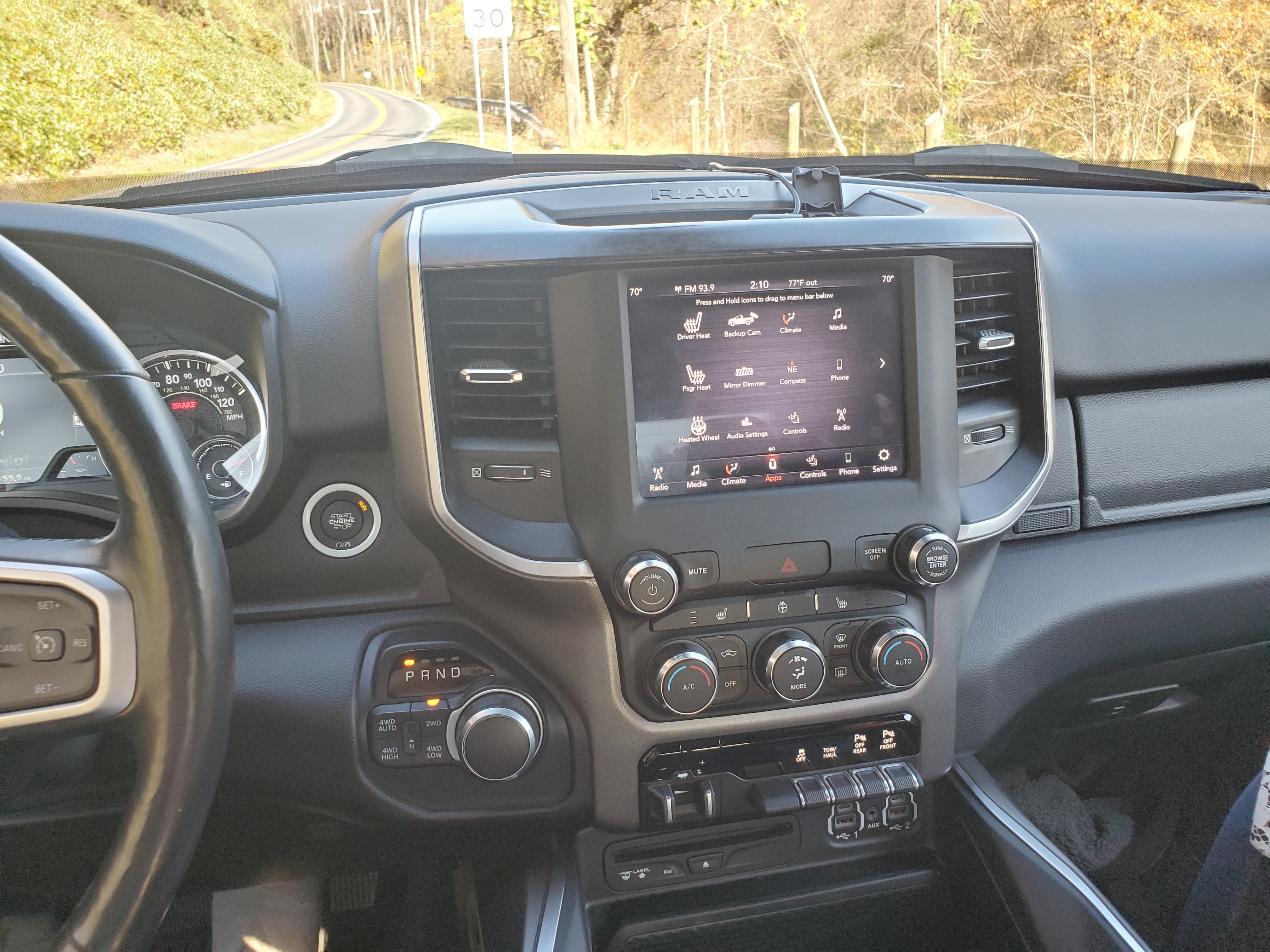
The curvy, charismatic lines of the exterior, for better or for worse, do not carry over into the cabin. Inside, FCA's designers have adopted the typical military-industrial stylistic slurry of hard angles, beveled edges, and square screens within thick, squared off bezels. The switches are all chunky and oversized (with very large print. FCA seems to like large fonts.), and they feel like they'd be easy enough to use even while wearing thick gloves. The infotainment system is par for the course for the segment, and it responds quickly to user inputs. The best thing about it is the large size of the screen. The cabin is of course also replete with smartphone connectivity as well as USB ports. The interior seems to reject the sleek, faux-luxury touches of most modern cars, replacing them instead with a generic, feel-good aesthetic of plastic-y utility, much like the feeling of unwrapping a cheap Home Depot impact driver, still slick and oily from the factory.
The view out of the cabin should be quite good; the greenhouse is tall, and the windows are large all around, even in the rear. However, this is hamstrung in practice by the height of the vehicle, as well as the tall, bulging hood and the long bed, not to mention the thick A-pillars. The huge mirrors help some, but they can't fix everything: The driver's situational awareness is ultimately not helped by their extra height from the road. Low-angle visibility for parking, plainly put, is nonexistent, and the parking sensors as well as the backup camera are near-mandatory for parking. The size of the truck, combined with its ponderous handling, make driving on narrow, twisty, or busy roads extremely stressful. However, for all these faults, the cabin of the Ram is quiet and comfortable, with well-made seats and plenty of space. If not commanding, this is certainly at least a comfortable place to drive from.
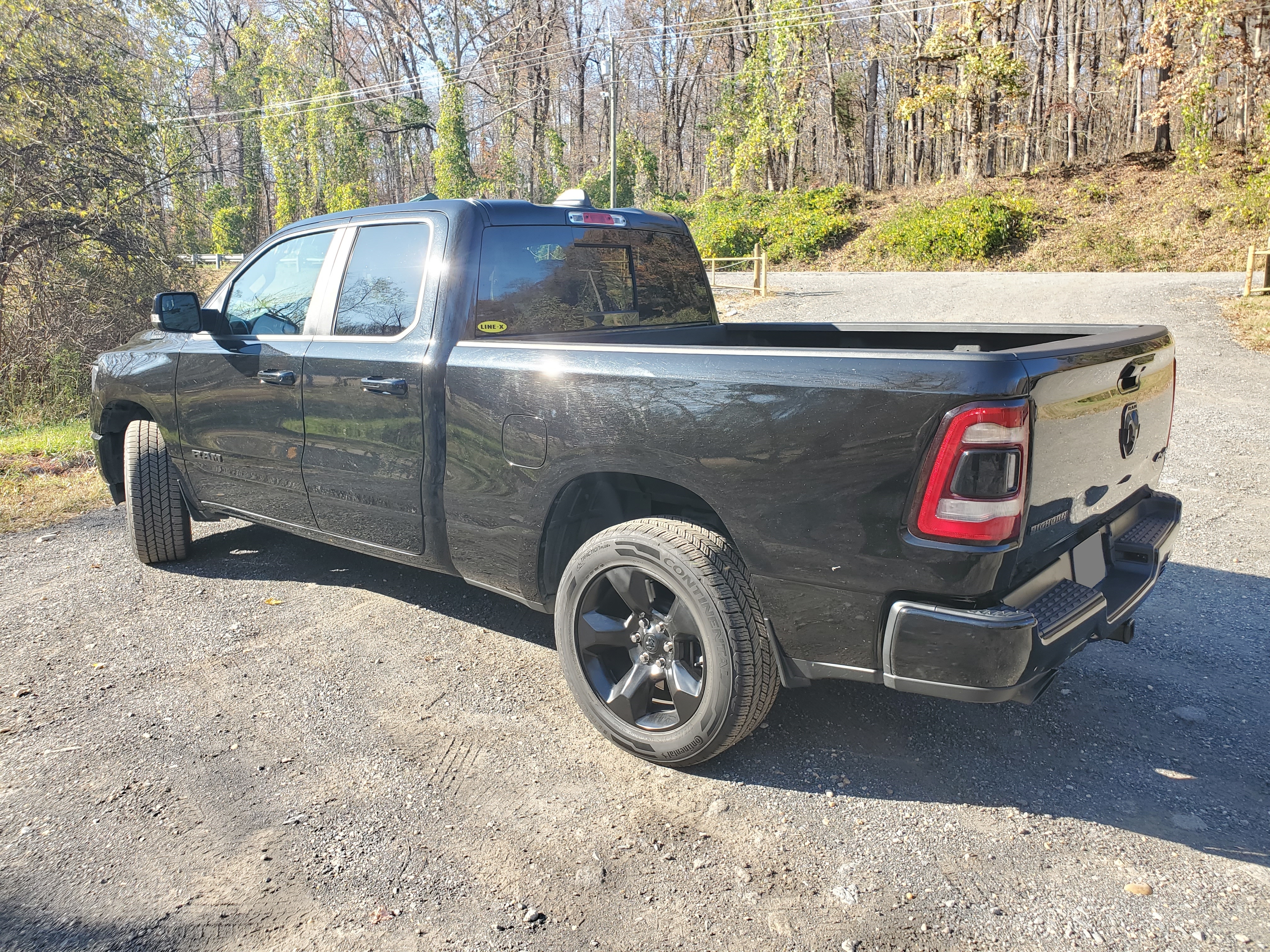
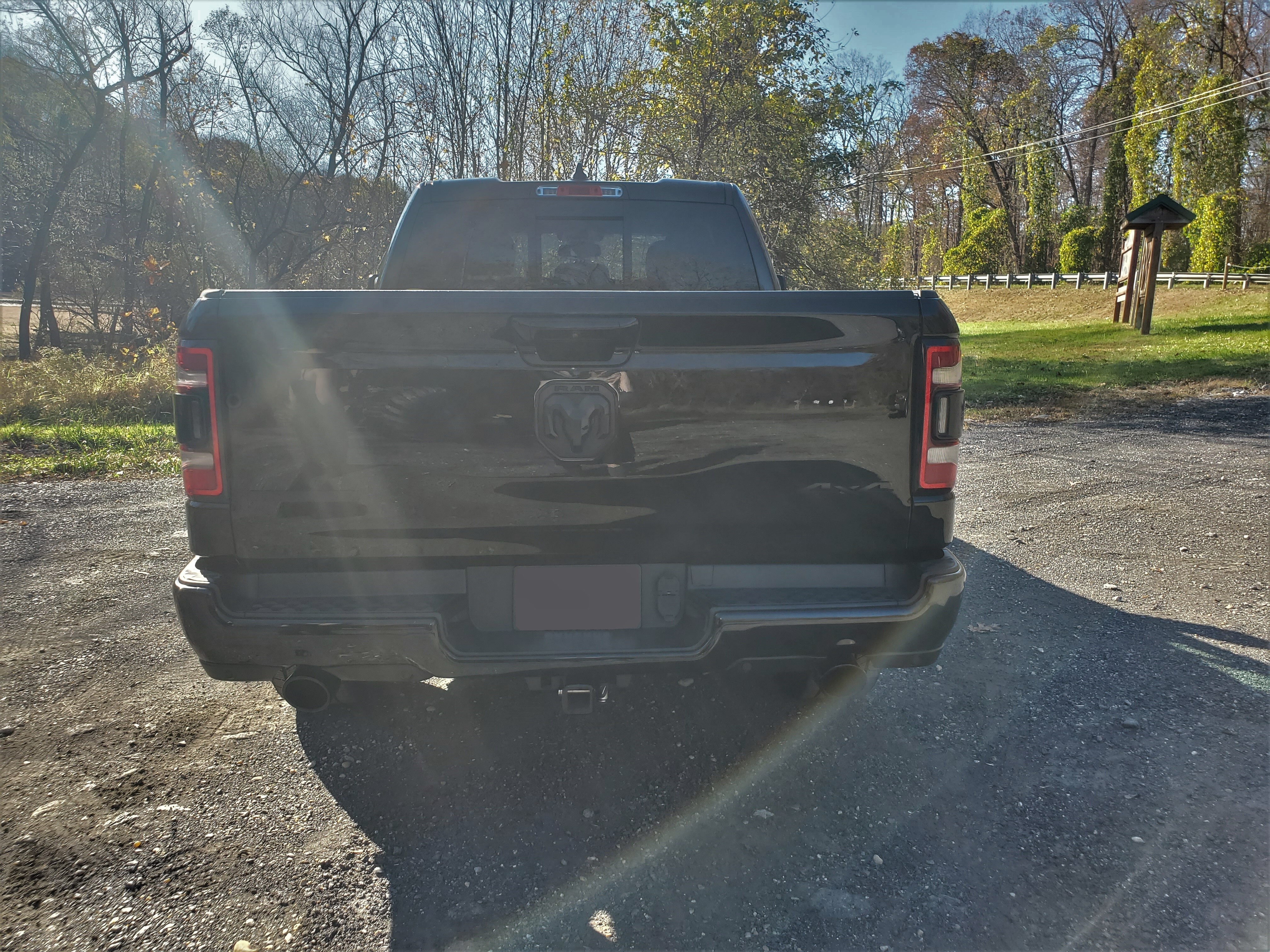
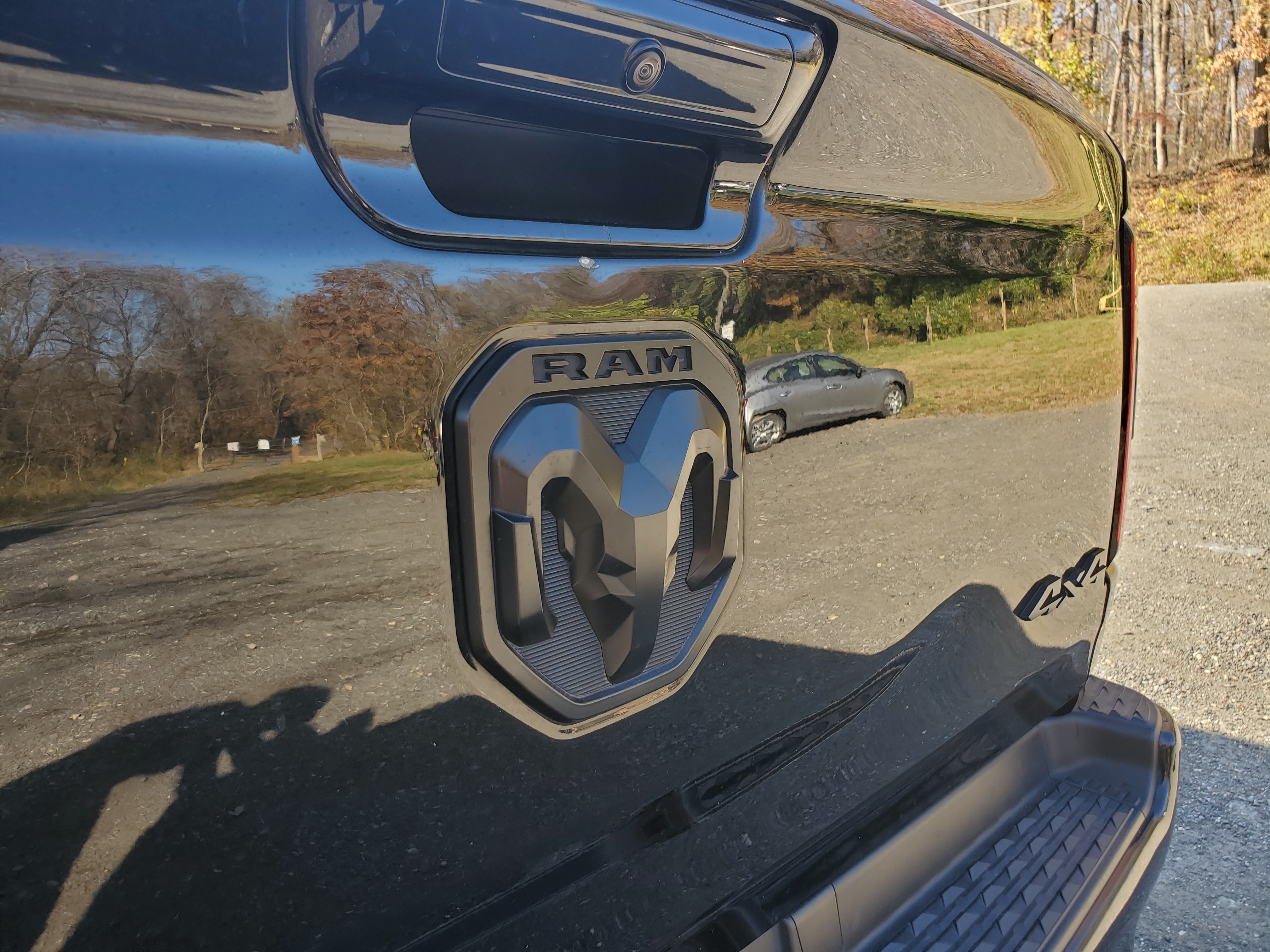
How is it to drive?
Simply put, the only thing that must be said is that this is very clearly a commercial vehicle. In order to accommodate heavy loads for hauling and towing, the rear end springs are extremely stiff, meaning that the rear end is nearly impossible to keep planted when the truck is unloaded. On any rough road, particularly in corners, the tires simply cannot hold on to the road and the rear axle bounces its way across bumps. That said, the Ram does have a five link coil spring rear end, as opposed to its competitors, which all use leaf spring rear axles. This lets FCA's chassis engineers decouple vertical stiffness from lateral and longitudinal compliance, and absolutely results in a superior ride; however, in this truck, with coil springs, the ride is still unnerving. Some higher trims come with air springs, and those models likely handle the road better. That said, they are still body on frame vehicles with solid rear axles and little weight in the rear when unloaded, and the camber-coupled nature of solid axles, as well as their unsprung weight, is impossible to ignore. One would think that light-duty pickups would have switched to De Dion suspensions by now, but no such luck. In normal driving, the Ram feels heavy and uncertain, and it doesn't handle its weight well. Any dynamic driving situation in which the inertia of the body matters feels ponderous at best and dangerous at worst, and the body roll doesn't help much with that. Again, higher trims get an air suspension system that can lower the truck for highway driving, but I doubt that this system meaningfully impacts dynamic responses. However, in situations where body inertia plays a smaller role, like highway cruising, the suspension generally acquits itself well. The steering is well-weighted and responsive, and is neither too heavy nor too vague. Highway driving is further improved by a quiet cabin with good noise and vibration control.

Though the ride and handling feel like a bus, the powertrain is different altogether. The eight speed automatic transmission is very well programmed and shifts smoothly, and the 5.7 liter V8 it is hooked up to quietly pumps out 410 lb-ft of torque and 395 horsepower. That characteristic V8 noise is kept quiet enough to never become annoying, but is still audible enough to be satisfying. Unladen acceleration is very good, and the engine's mountain of torque briefly makes the Ram feel like a much smaller vehicle. This trim also boasts a four wheel drive system with a two speed transfer case; that said, the average user will likely never need this. The powertrain is responsive and predictable, and the driver never feels as though the vehicle is struggling to keep up with their inputs. This drivetrain is controlled through both a dial shifter and gear limit controls on the steering wheel; though positioned like volume keys, they are easy to reach and simple to understand, and are surely invaluable for towing. The dial shifter is less intuitive than a column shifter and its detents are too light, but it still works fine. Reining in this powertrain are four-wheel disc brakes with remarkable stopping power. The parking brake control is less than ideal, being a small pull switch low down on the outboard dash, and I found myself repeatedly stomping air trying to kick a parking brake that wasn't there, then groping for far too long for the miniscule parking brake switch. This feels like a parking brake design that in fact actively discourages its use, a curious ergonomic decision indeed.
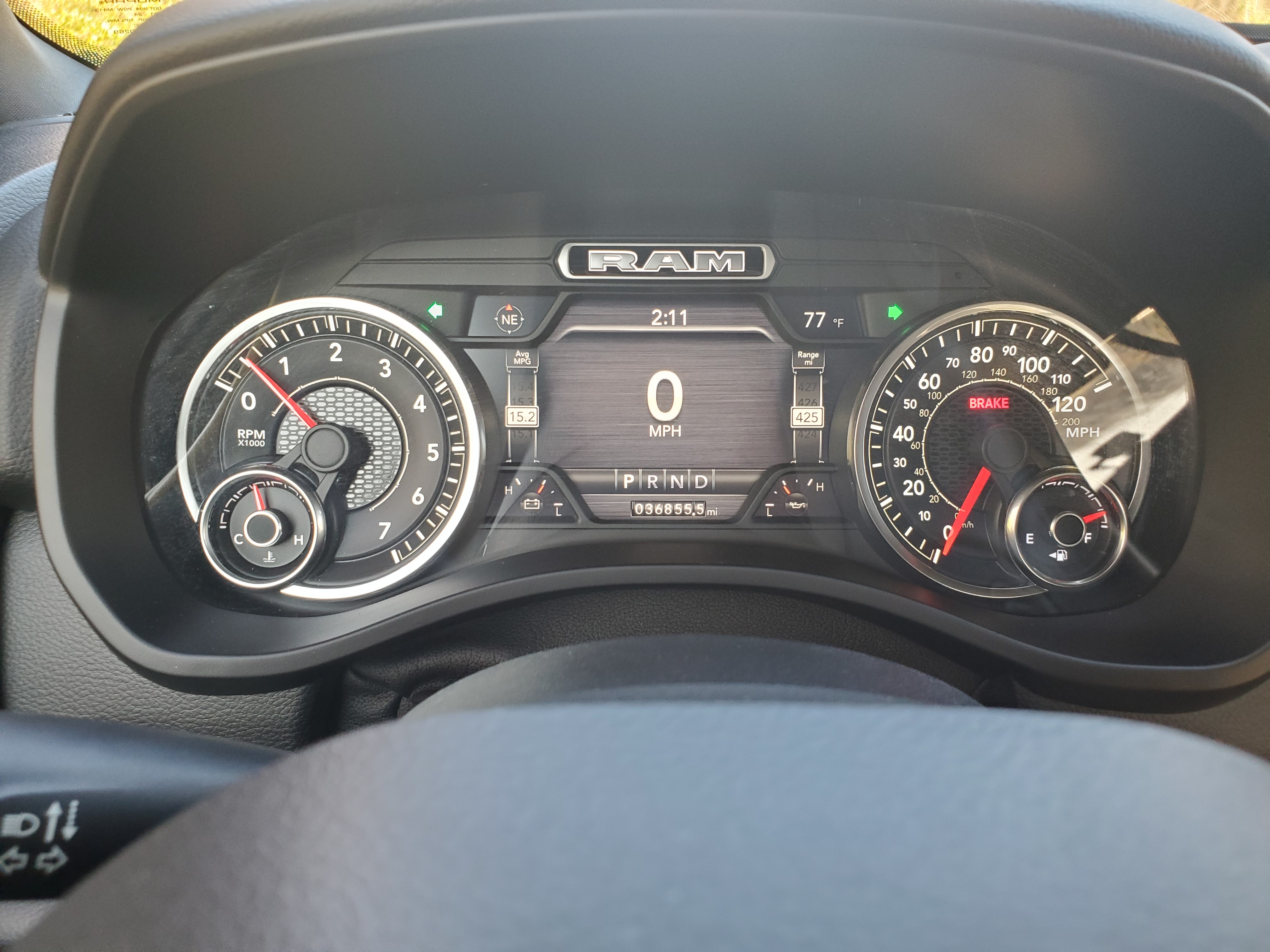
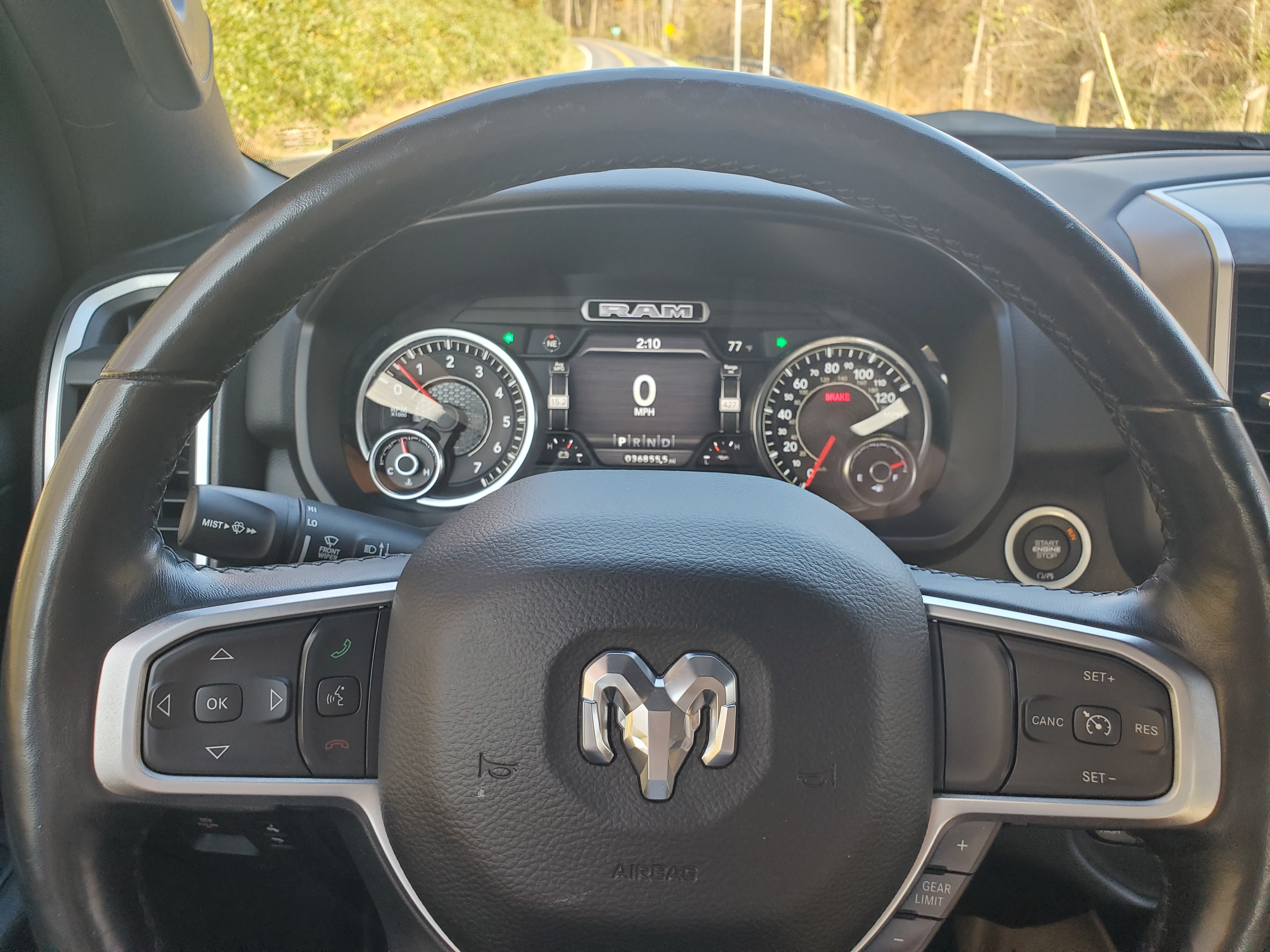

All in all, the Ram 1500, for all its consumer-friendly features and comfort, is still a cargo vehicle at heart. The heavy body-on frame construction, solid rear axle, and stiff springs are far more at home hauling trailers down the interstate than they are in a Wegmans parking lot or on a twisty back road. However, the spacious and quiet cab makes the Ram an excellent vehicle to work or travel in, and the drivetrain is about as efficient as can be expected of a full size pickup. Torque is prodigious, and the traction control system and transmission prevent it from being wasted ruining the tires, and despite all the truck's drawbacks, the engine's spirited roar at full throttle is more than satisfying. The 4x4 system is nice to have, but ultimately unnecessary, and the user would be better served simply opting for 4x2 with a locking rear differential instead. What it really comes down to, though, is that the Ram affords the user space...at the cost of space. Yes, the cabin and bed are massive, but so are the exterior dimensions. Parametrically, this truck is a stupendous automobile: You get space, power, capability, and comfort (sort of). But all that comes at a cost. Yes, admittedly some of those costs have been outsourced, like through artificially depressed gas prices or by outsourcing your risk of death to the poor fools in the Civic you just hit, but other costs are unavoidable. Fuel economy is the most obvious one, but the unsuitability of this truck for everyday scenarios stands out as well: It is simply very large, very difficult to see out of, and not very maneuverable. It is difficult to park and difficult to drive. Or perhaps I should say it is difficult to drive well. After all, anybody can hop into a Ram, put it in Drive, and make the Hemi roar. But to be aware of the positioning of the truck on the road? To pay constant attention to its stopping distance, its distance from other cars, from the lane markings, to ensure that one isn't being a totally antisocial road user? That's legitimately difficult. This is a very easy vehicle to drive poorly, and a difficult and tiring one to drive well.
But we've talked about the negative consequences of trucks enough. Let's ask the harder question:
What does it sell?

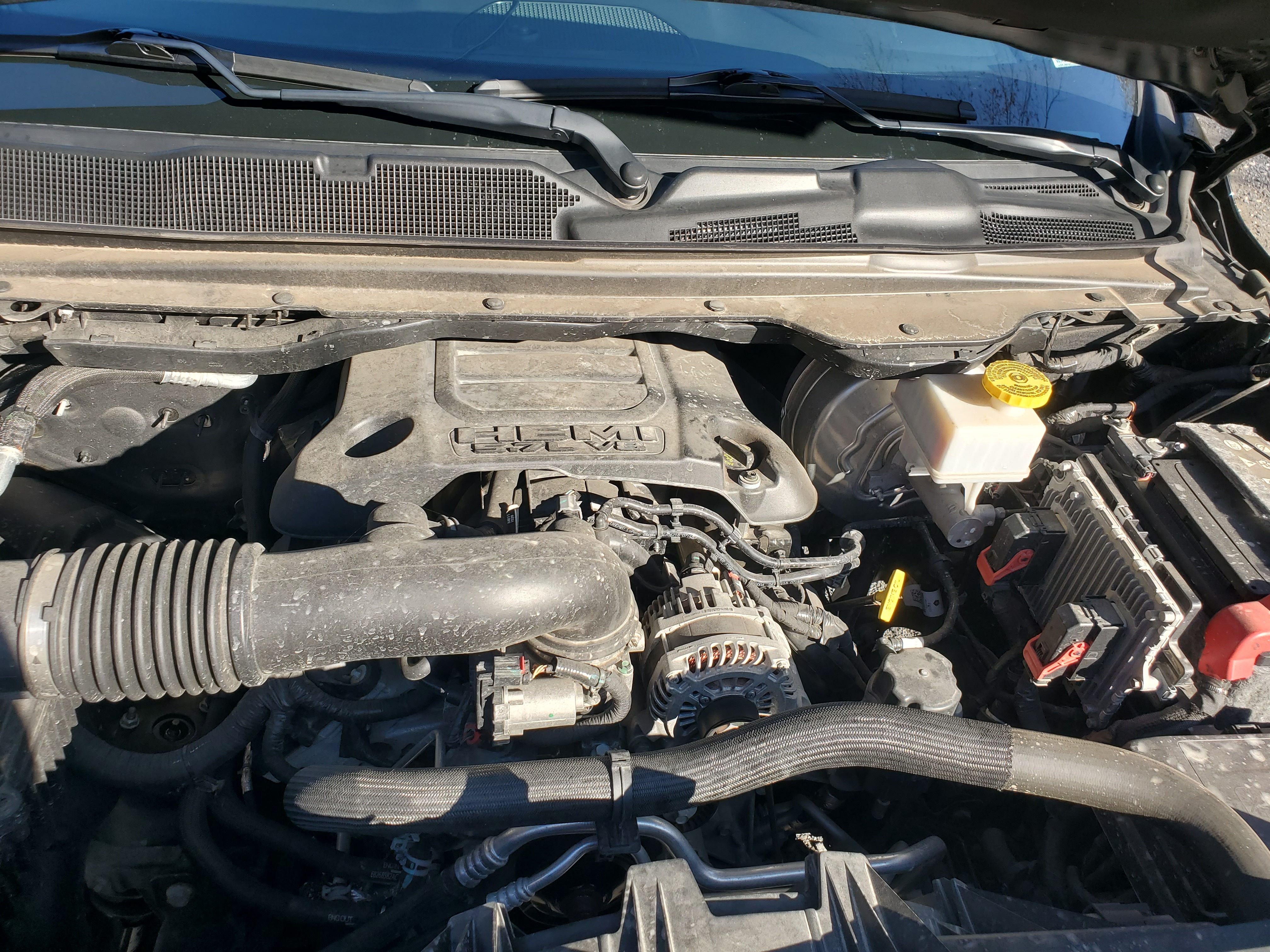
It is difficult to call the Ram an enthusiast vehicle. Its only real driving performance appeal is the huge torque its engine offers, but when it comes to anything short of a wide, straight road, the driver starts to sweat, as they have to muscle its mass and height through corners. Again, this is a cargo vehicle at heart. So what is it that makes people like it so much? Brett Berk writes for The Drive that "the highest indexed use among truck owners is pleasure driving," and that that they "use their vehicles this way fully twice as often as the industry average." We must remember, though: A vehicle's outright acceleration, cornering, and other sporting capabilities are only part of the story. Consider instead the quiet cabin, the interior reminiscent of power tools and machinery. Perhaps the size, the height, the sheer mass, are the point. Is this just meant to be a consumer-accessible, commuter-friendly semi tractor? Perhaps the Ram is meant to feel like a cargo vehicle. Perhaps the ways that its nature as a truck compromises its practicality, its sheer utility as a car, are part of the point. What if the Ram doesn't merely sell the ability to become big, powerful, stronger than everyone else. What if the Ram sells the ability to become a machinist? In that case, the driving characteristics are a good thing, as they reinforce the impression for the driver that they are carefully, competently operating not a truck, but a piece of specialized machinery. You aren't a commuter, you're a trained professional. You're a specialist. You're a skilled worker, embodying the blue-collar industrial base that eulogies for the American spirit so often fall back on. And when you don't care to focus on your specialized machinery, the quiet cabin and sheer size (the bigger vehicle always wins, after all), as well as any driver-assistance features you paid for, will keep you feeling safe. You can disengage from the driving experience at will, or you can engage as much as you want, but the Ram will accommodate either. This messaging, that a pickup truck turns you not only into a cowboy, but a tradesman, cuts to the heart of the appeal of pickup trucks. It leverages the decades-old association of pickups with the working class, with honest dependability, and moralization of hard work and lifelong careers, but it does this in such a way that it's tolerant of the rapidly ballooning size, capability, and price of modern pickups. This messaging is price-ambivalent, because of course it's expensive, it's a specialized machine. This truck is meant to feel like a Bridgeport mill with heated seats.
The conflation of the American skilled working-class fantasy with honesty and dependability, industry and production, however, is complicated, and not entirely accurate. The modern working class is quite different from that 19th century conception of labor: Tamara Draut writes for Demos that " the term “working class” is conflated with white and male identities, frequently used as a short-hand to conjure the former archetype of the working class as a white man who works in manufacturing," and that "today’s working-class is centered in the service and caring economy." Simply put, the reality of living in the post-industrial developed world, where the real industrial base has been shipped overseas, is that a scarce few of the working class truly work in manufacturing. Using "working class" as a byword for honest work is a fantasy, simply put. But with a pickup truck, maybe that doesn't matter. Maybe the point of the modern pickup truck is to reify that fantasy, not use it as a crutch. Perhaps the point of this truck is that it makes anything you do into honest work, be that running a chain of car dealerships, overseeing an office park full of programmers, or trying to run the Biden campaign bus off the road. So in that case, it doesn't matter that 75 percent of pickup trucks almost never tow. It doesn't matter that the majority of truck owners don't go off road, don't haul. They're still built for honest work, and sold for honest work, because on a textual level, an emotional level, they're always doing honest work. It begs asking then: Why do we sell ourselves fantasies of work? Why should the cars we love be sold to us on the basis of work, of productivity? Why don't we aspire to leisure? What have we done?
I rented this truck with Turo, a crowdsourced car rental platform.